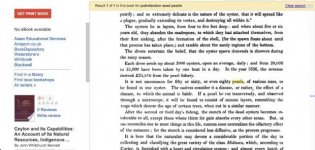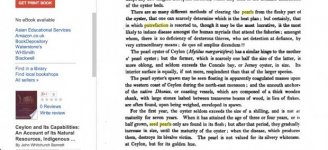You are using an out of date browser. It may not display this or other websites correctly.
You should upgrade or use an alternative browser.
You should upgrade or use an alternative browser.
My Natural Pearl Collection
- Thread starter MSC
- Start date
FrenchPearl
Member
- Joined
- Feb 9, 2013
- Messages
- 155
Awesome investigative work Andrea !! those earrings are gorgeous and now have a credible origin !
Enjoyed reading through your and Caitlin posts on that particular piece.... Still reviewing the whole thread before I pronounce my absolute favorite
Enjoyed reading through your and Caitlin posts on that particular piece.... Still reviewing the whole thread before I pronounce my absolute favorite
MSC
Natural Pearl Lover
- Joined
- Oct 11, 2012
- Messages
- 2,861
I was really happy to hear back, I honestly did not expect to. I want to get my hands on the exhibition book as well, but the price is prohibitive at the moment (like a couple hundred bucks prohibitive!). There is another book as well that the other shop owner recommended: Jewellery in Malta, which is also very expensive. And the wishlist grows!
MSC
Natural Pearl Lover
- Joined
- Oct 11, 2012
- Messages
- 2,861
Oh, I forgot to add another reply from the exhibition curator regarding where Malta sourced their pearls from during the late 1800s:
"Dear Andrea,
Unfortunately we are not sure of the source of the seed pearls. They were certainly available in large quantities, judging by their extensive use on traditional jewellery, in Malta and in Italy however they do not seem to occur naturally in the Mediterranean. Bearing in mind that Malta was one of the chief coaling stations in the Mediterranean and that the opening of the Suez canal meant even more maritime trade passing through our harbours it could well be that pearls were sourced from as far away as india or the gulf. I have heard old jewellers say they would get them from Italy, however the Italian source would likely have brought them from elsewhere so that doesn't help much. It is one of the questions that I am grappling with and hopefully eventually further research will clarify this matter for us.
Kind regards,
Francesca "
"Dear Andrea,
Unfortunately we are not sure of the source of the seed pearls. They were certainly available in large quantities, judging by their extensive use on traditional jewellery, in Malta and in Italy however they do not seem to occur naturally in the Mediterranean. Bearing in mind that Malta was one of the chief coaling stations in the Mediterranean and that the opening of the Suez canal meant even more maritime trade passing through our harbours it could well be that pearls were sourced from as far away as india or the gulf. I have heard old jewellers say they would get them from Italy, however the Italian source would likely have brought them from elsewhere so that doesn't help much. It is one of the questions that I am grappling with and hopefully eventually further research will clarify this matter for us.
Kind regards,
Francesca "
hbyrne
Community member
- Joined
- Jun 18, 2013
- Messages
- 186
How did I miss THOSE earrings? Filigree and teeny pearls together? ...and they are flowery, leafy shapes.... It's almost too much for me ;-)
Also, such an interesting conversation too, I'd never heard of Oaxacan jewellery. I'm learning so much, thank you both.
Also, such an interesting conversation too, I'd never heard of Oaxacan jewellery. I'm learning so much, thank you both.
Caitlin
Well-known member
- Joined
- Dec 11, 2004
- Messages
- 8,502
Oh, I forgot to add another reply from the exhibition curator regarding where Malta sourced their pearls from during the late 1800s:
"Dear Andrea,
Unfortunately we are not sure of the source of the seed pearls. They were certainly available in large quantities, judging by their extensive use on traditional jewellery, in Malta and in Italy however they do not seem to occur naturally in the Mediterranean. Bearing in mind that Malta was one of the chief coaling stations in the Mediterranean and that the opening of the Suez canal meant even more maritime trade passing through our harbours it could well be that pearls were sourced from as far away as india or the gulf. I have heard old jewellers say they would get them from Italy, however the Italian source would likely have brought them from elsewhere so that doesn't help much. It is one of the questions that I am grappling with and hopefully eventually further research will clarify this matter for us.
Kind regards,
Francesca "
I wonder if there will ever be a definitive test for origin of pearls. Meanwhile, if the old pearls on a piece look like Gulf pearls, they probably are. Coincidentally the vast majority of pearls found in the Gulf were always the tiny ones... That's why any really round 7mm and up is worth 5 figures. I think, though I am not positive that more than half if not almost all the opened oysters had tiny at least grains of sand especially on the edges, that were actually pearls. Come to think, that could be the origin of that myth. But until recently, they were of no consequence and little value unless you collected a lot of them and they were drilled. I am talking 1mm and under. the least expensive gulf pearl necklaces are made out of a few pale, pale, gold-like misshapen pearls around 5mm which taper to 3 then 2mm then about 2-3 inches on each side are minute pearls, 1mm and under. I have collected about four of those least expensive necklaces, and I have about 20 inches of 1mm and smaller. Half are 2mm and the other 10" go from 3 mm up to 5.5mm-
(Not counting my inherited Gulf pearls which are roundish to the eye quite white and run from 6+mm to the smallest at 3mm. It is better quality than the ones with the tiny grain of sand pearls...
)
Thanks to Dawn, I saw some teeny, tiny, gulf pearls that were probably .2mm drilled. No needle I know could go through those! What a tour de force drilling them must have been! And also, thanks to Dawn, I saw a teensy tiny necklace where the pearls were perfectly round and quite white, going from 2mm to about 1/3 mm, Exquisite!!!! I don't have photos due to my computer problems of 2013.
hbyrne
Community member
- Joined
- Jun 18, 2013
- Messages
- 186
I think, though I am not positive that more than half if not almost all the opened oysters had tiny at least grains of sand especially on the edges, that were actually pearls.
Caitlin...I've been wondering about this for a while. I've seen a post here on the forum (by Dave, I think) with a pic of a very poorly oyster which had hundreds of teeny, tiny pearls. Can there be a link? Maybe the oysters then were sickly ones? I also remember from somewhere that the collection of this kind of miniature pearl involved some kind of putrefaction?
pattye
Pearl Scholar
- Joined
- Dec 26, 2005
- Messages
- 11,541
LOVE these earrings and pendant! So interesting to see the construction of the earrings, too. Thanks much for sharing the results of your research, too.
Andrea, perhaps you've seen this before, the tiny pearls are drilled by hand, with the pearl against a stump of wood.
Andrea, perhaps you've seen this before, the tiny pearls are drilled by hand, with the pearl against a stump of wood.
Last edited:
MSC
Natural Pearl Lover
- Joined
- Oct 11, 2012
- Messages
- 2,861
Andrea, perhaps you've seen this before, the tiny pearls are drilled by hand, with the pearl against a stump of wood.
I sure have, very impressive! I'd like to see it in person too!
Lagoon Island Pearls
Well-known member
- Joined
- Dec 8, 2009
- Messages
- 2,117
Caitlin
Well-known member
- Joined
- Dec 11, 2004
- Messages
- 8,502
Caitlin...I've been wondering about this for a while. I've seen a post here on the forum (by Dave, I think) with a pic of a very poorly oyster which had hundreds of teeny, tiny pearls. Can there be a link? Maybe the oysters then were sickly ones? I also remember from somewhere that the collection of this kind of miniature pearl involved some kind of putrefaction?
I think Dave has learned and is doing many of the things the old time pearlmeisters knew and that most any phenom he sees has been seen before, unless it is something to do with the low temperature or high latitude or something, but in general, scientists minds work the same and always have. They notice and count and remember and maybe try to influence more accidental pearl production, than avoid it, as Dave has said he does. He tries not to do anything that will cause a pearl, but he could, and his pearl per mollusk average is high because he knows his stock and what to look for and where to go when.
I think he is a laboratory of what a curious pearl person will find and do whenever and where ever.
hbyrne
Community member
- Joined
- Jun 18, 2013
- Messages
- 186
Similar threads
- Replies
- 3
- Views
- 1K
- Replies
- 1
- Views
- 302


